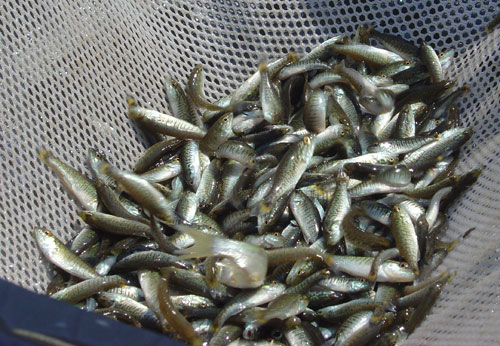A typical fish stocking strategy for ponds varies by pond type. Cold water ponds are different than warm water ponds, and so is the management of those water bodies. A good rule of thumb for warm water ponds would be about 1,200 bluegills, 75 largemouth bass, and about 100 catfish per acre of water. With that said, many pond and lake owners like to stock bluegill and catfish to increase the size and population of bass. This can work, but catfish are not always a good idea for every pond situation.
Because ponds and lakes vary so much, fish stocking strategies must vary between water bodies, even on the same property! It is always a good idea to contact your local fisheries biologist or even a lake management expert before you stock your pond. I would caution against contacting a fish hatchery. Though many are good guys, remember that these companies are in the business of selling you fish. By identifying the proper stocking rate for your pond up front you will likely save yourself both time and money. Identifying your objectives and goals up front will mean that your first fish stocking could very well be your last.
The rate at which your pond is stocked with fish will depend on your pond management program. In short, whether you fertilize your lake or not will make a big difference in the fish carrying capacity. Persons stocking unfertilized ponds should stock about 500 bluegills, 50 bass, and about 75 catfish per acre. On the flip side, persons stocking fertilized–or naturally fertile ponds–should stock about 1,000 bluegill, 75 bass, and 150 catfish per acre. If you plan on feeding the fish within your pond, then you can even add about 25 to 50 more bass a bluegill per acre.
For pond owners that want only catfish, it is suggested that about 150 catfish be stocked per acre after a prior stocking of forage fish, such as fathead minnows. If the pond is naturally fertile or pond fertilization is planned, then a stocking rate of 300 catfish per acre is recommended. Fertilization allows a pond to be more productive, but nothing means quality fish production like fish feeding. If feeding of catfish is planned, then pond owners can stock up to 1,000 fish per acre! Keep in mind that the rate at which any fish grows is a product of it’s environment, and your pond management objectives must always be kept in mind. Too many fish with not enough food means small fish. On the opposite hand, abundant food with fewer fish means faster growth and bigger fish!
These fish stocking rates are generalizations for all around pond and lake management, so you can replace bluegill with redear sunfish or other perch. Remember that predatory fish such as largemouth bass should be stocked several months after establishing the forage populations of bluegills or fathead minnows or fingerling channel catfish. The stocking rate for largemouth bass will very much depend on your bass management goals. More bass means smaller bass, while fewer means you will grow large bass!
